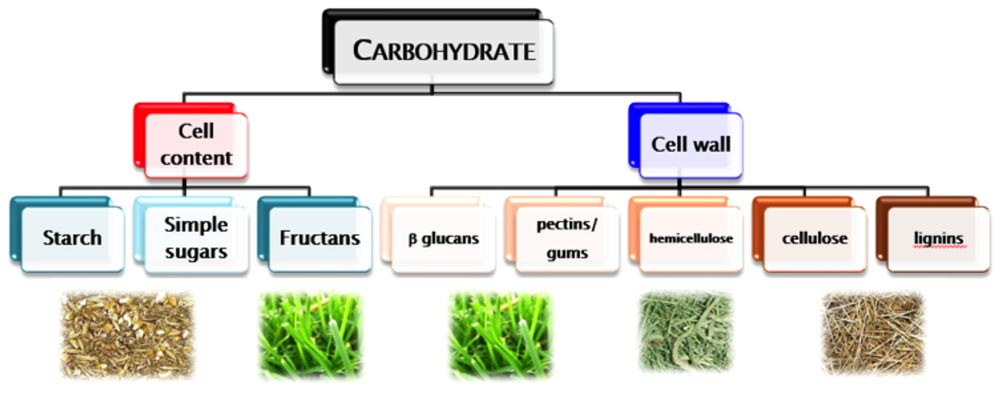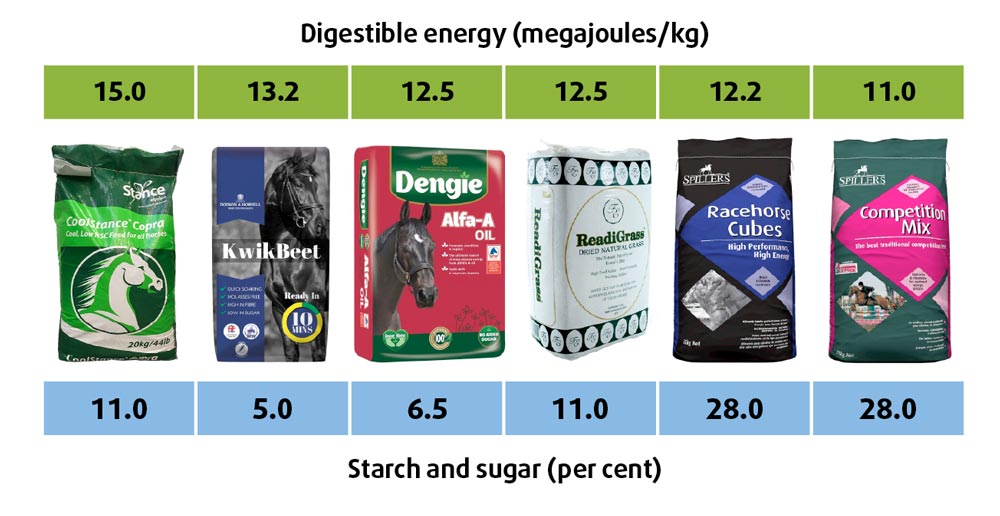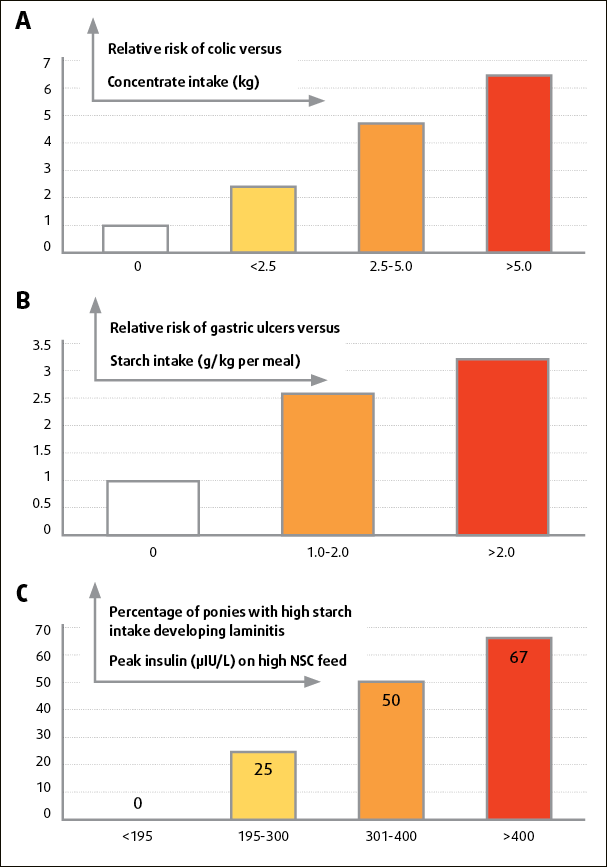25 Jun 2018

So many medical problems in horses can be understood better by considering the conditions under which horses spent 50 million years of evolution, and then contrasting this with the conditions of modern management in very recent years.
The air they breathe, the food they eat, the company they keep as well as the exercise they undertake all differ markedly from that their anatomy and physiology developed and adapted to. Nutrition, one of these fundamental changes, is known to be at the basis of numerous serious health concerns, such as colic, respiratory disease, orthopaedic disease, liver disease, laminitis and gastric ulceration.
Although it is often impractical to exactly mimic the nutritional quality and patterns of feeding typifying ancestral or feral equids while still maintaining the expectations of the horse owner in terms of performance, lessons can still be taken from comparing probable historical nutritional experiences.
Although the earliest recognisable equid ancestors (55 million years ago) browsed on dicotyledonous plants and fruits, an almost unimaginably slow evolution into a grazing animal followed, in response to the gradual expansion of grasslands and decline of woodland ecosystems during the Miocene period approximately 18 million years ago.
Study of modern feral equids confirms their continuing status as grazers, with typically around 90% of dietary intake composed of grasses, sedges and rushes. Indeed, grazing is the prime activity of feral horses, ponies and donkeys, occupying between 12 and 20 hours per day and leading to a constantly “trickle-fed” gastrointestinal tract.
Along with domestication of the horse came a requirement for improved dietary quality to match the energy expenditure associated with the exertional activities required of them. Although changes in dietary quality associated with domestication probably began approximately 7,000 years ago, this is a brief period of time in evolutionary terms and the more recent vast choice of feeds available to the horse owner has probably only spanned the past few decades.
Observational studies of domesticated grazing ponies or stabled ponies with free access to forage indicate time spent feeding is no different to values in feral animals, and typically around 16 hours per day, and voluntary fasting never extends longer than 3 to 5 hours. Furthermore, ingestive behaviour is significantly increased by social interaction and visibility of other horses and continual ambulatory activity is also an integral part of grazing behaviour.
Carbohydrates form the majority of an equine ration and have a major health impact. The carbohydrates in the cells of the plant material horses eat is broadly divisible into structural cell wall fractions and non-structural carbohydrates (NSCs; Figure 1). The term water-soluble carbohydrates (WSC) will also be seen, which generally indicates the fructan and sugar content only, as starches are insoluble in water.

UK grasses and forages tend to have very little starch and store carbohydrates as sugars and fructans. Clovers and alfalfa may contain more starch, as will cereals. The structural carbohydrate fibre fractions are indigestible, but can be slowly fermented to a greater or lesser extent (for example, pectins and beta-glucans versus lignins and celluloses) by the gastrointestinal microbiome, resulting in volatile fatty acids on which the horse depends as a major energy source.
The NSCs are more readily and rapidly absorbable/digestible/fermentable, with energy derived from simple sugars or fatty acids as end products. However, it is wrong to assume high NSC feeds will provide more energy for the horse than high-fibre feeds. Indeed, it should come as no surprise horses can very effectively assimilate calories from fibre given they have spent 50 million years adapting to this type of diet.
Some of the highest energy feeds available for purchase for horses in the UK are high fibre and low NSC (Figure 2), indicating sugars and starches are not a prerequisite component of high energy diets. Under modern management systems, many horses are fed relatively energy-dense, high-NSC, low-fibre and occasionally high-fat feeds in meals that are often consumed in a relatively short period of time, leaving the stomach relatively empty for significant periods of time.

When complete pelleted or concentrate diets are offered, only around 4 to 10 hours per day is spent feeding, with increased time spent on other behaviours, such as wood chewing and coprophagy. A clear and linear association exists between ingestion of NSCs and adverse health consequences, such as colic, gastric ulceration and laminitis (Figure 3a, b and c), meaning efforts should always be made to limit NSC content in favour of structural carbohydrates wherever possible and practical.

Furthermore, many differing choices and sources of preserved forage and concentrated feed are available to the horse owner nowadays, creating a greater likelihood of abrupt dietary changes that might result in colic or diarrhoea. Anecdotal comments from owners about particular feeds that have upset their horse’s GI tract are often based in an abrupt change, whereas a slow and gradual change may well have been tolerated.
Although natural and ideal ingestive behaviours may be best mimicked by turnout to grass, the quality of the grass almost invariably differs dramatically from the optimum nutritional balance of cell-wall fibre versus NSCs, meaning even grazing can be detrimental.
Veterinary surgeons will often be asked to advise on equine diets, and they represent one of the very few sources of independent advice in this respect.
When formulating an equine diet, the following is a simplified sequence to go through:
As a general rule, voluntary feed intake of horses will approximate 2% to 3% of their bodymass as dry matter (DM) each day. If highly palatable feeds are offered (for example, grazing) and/or if the individual is a greedy eater, this may be in excess of 5%. If the diet is 100% preserved forage, it is unlikely to be much greater than 2% to 3%.
Horses with dental disease could consume below 2%. Weight loss will generally be achieved when between 1% and 1.5% is fed and intake should never be allowed to fall below 1% of bodymass as dry matter.
Dietary energy requirements in horses are generally expressed as apparent digestible energy (DE; equals ration energy minus faecal energy). This should be expressed in kilojoules (kJ) or megajoules (mJ), although US publications will use Kcal and Mcal (conversion of Jàcal × 0.239; calàJ × 4.186). Daily maintenance requirements of non-pregnant adult horses living in a field without additional exercise are considered to typically lie between 127kJ/kg to 152kJ/kg body mass.
Clearly, if weight loss is a concern, the upper end of this range is likely to be the target. The average daily maintenance DE requirements for horses (in mJ/day) can be roughly estimated by dividing kg of bodyweight (bw) by 7 (for example, 500kg bw/7 = 71mJ/day), although an additional 10% might be added to this approximation if weight gain is needed (for example, 78mJ/day for 500kg bw).
Light exercise should be encouraged, where possible, to maintain musculoskeletal strength and perhaps general well-being. However, even light exercise may increase DE requirements by at least 20% (for example, a further 15mJ/day for 500kg bw), with heavy exercise approximately doubling DE requirements (for example, up to 300kJ/kg body mass).
Daily crude protein (CP) requirements for field maintenance typically lie between 1g/kg to 1.5g/kg body mass. This typically corresponds to a CP concentration of around 6% to 8% in the overall ration. There appears little harm in increasing protein concentration modestly, and, therefore, overall CP of perhaps 8% to 10% seems appropriate, especially where forage is the primary protein source and might lack certain essential amino acids.
High-protein feed balancers are a very useful component of diets as a means of ensuring good protein intake by adding a small amount of concentrated protein (and minerals/vitamins) to the ration. Again, exercise will increase protein requirements to as much as 2g/kg daily.
A horse’s GI tract is designed to ferment forage and poor-quality grasses, and this is generally the best diet for maintenance of GI health. However, forage nutritional quality is highly variable and frequently unknown to the owner, which is a fundamental concern when this is generally the major nutrient source provided.
Forage analysis is readily available and inexpensive via several feed suppliers and is a useful adjunct to dietary planning. Hays might typically contain between 6mJ/kg and 10mJ/kg DE and 4% to 12% CP as DM. Thus, low protein content can frequently be a concern. Furthermore, it is not unusual to find WSC content (that is, sugars and fructans) can be remarkably high in some hays (for example, greater than 20%) and can be a significant insulin stimulus.
Although NSC may often be lower in haylages, their ability to provoke higher insulin responses than hays is a concern in cases of endocrine laminitis. For maintenance requirements most forages when offered ad libitum will almost invariably represent adequate, and frequently excessive, DE intake in healthy individuals, but older horses in poor condition, and perhaps with dental and absorptive problems, may struggle to keep weight on with even free access to good-quality forage, especially if protein is low. Increased levels of exercise will require supplementary feeding as the energy requirements will not be met by forage alone.
Clearly, masticatory ability is crucial to forage consumption and digestibility. Where necessary, consideration should be given to using commercially available chopped and processed forage that may be generally above average nutritional quality, and also the chopped nature suits horses with dental problems better – for example, alfalfa, grass cubes and chaffs (Figure 2).
These diets can become a partial or total hay substitute where appropriate. If access to good-quality hay or haylage is available, then purchase of a garden shredder can enable manufacture of home-made chaff that can be fed to horses with masticatory problems.
When forage alone does not supply adequate calorific intake, further high-fibre feeds should be offered in preference to cereal-based mixes. Non-molassed sugar beet pulp is one of the highest energy fibre feeds (typically around 13mJ/kg), with reasonable CP (10%) and provides an excellent source of low starch and sugar (less than 5%) calories. Similarly, coconut-based meal (for example, Coolstance Copra) contains even higher DE (15mJ/kg), high protein (20%) and acceptable NSC (11%).
Also, chopped alfalfa products (often around 10mJ/kg to 12mJ/kg DE and 12% to 16% CP) might be considered before cereal starch-based feeds are added to the diet for energy. Some “complete” pelleted feeds are also available for horses, but it is important to establish whether the sugar/starch content is low (ideally less than 10%) and the fibre content high (preferably greater than 25% crude fibre). Where possible, at least some chopped hay or chaff should be fed alongside these “complete” diets.
Vegetable oils typically provide approximately 40kJ/ml (4mJ per 100ml). They can be fed relatively safely to horses, although they may decrease fibre digestibility in the colon at high levels. Typically, a gradual increase from 0.1ml/kg bw up to a 1.0ml/kg bw for about two weeks will be acceptable to most horses should they require the extra energy.
Palatability can be an issue, although for increased calories any edible oil is fine – for example, maize, sunflower, granola, vegetable and coconut. Linseed and soya oils tend to be expensive. Margarine can be given if preferred by the horse. When fed at 1ml/kg bw daily, vegetable oil will provide around a quarter of normal maintenance DE requirements and tends to produce a very attractive shine on the horse’s coat.
A small amount of cereal-based mix might be useful as an energy and protein supplement and is easily consumed when dentition is poor and requirements are not being met by fibre and oil diets. An additional benefit for competition horses is energy density, where there is reduced gut-fill associated with the additional calories.
Such mixes and cubes are typically between 10% and 30% starch and 9mJ to 13mJ DE per kg, but should never be offered at a rate of more than 1g/kg starch per meal (about 1kg to 2kg feed per 500kg).
In insulin-resistant subjects (for example, pituitary pars intermedia dysfunction cases) these cereal-based starchy feeds should generally be avoided as they are particularly hyperinsulinaemic and may increase the risk of laminitis.
Commercially available “ration-balancers” are widely available for provision under such circumstances. Typically, a small quantity of pellets is given, which contains a concentrated mix of proteins (for example, 15% to 25%), minerals and vitamins.
Starch may appear high in these balancers (for instance, 20% to 25%), but is generally not much of an issue given the small amount fed. Particular consideration might be given to antioxidant vitamins C and E, especially where high oil levels are being fed. The addition of 1IU/kg/bw to 2IU/kg/bw vitamin E is reasonable.
With nutritional resources widely available to horse owners in the UK, much can be done to maintain requirements in working and sedentary horses without creating additional diet-related health risks associated with high-NSC feeds.
The main combined aims of offering high-energy, adequate protein, high-fibre, low-sugar and starch feeds are readily achievable given a multitude of possible feed constituents.
Clearly, close monitoring of key age and nutrition-related health concerns, including colic, ulcers and endocrinopathic laminitis, should also parallel involvement in the dietary planning.